When DriveLife went to the launch of the next-gen Ford Ranger, we came away impressed. In fact, we came away in the new Ranger V6 Sport. Leaving the launch in Haumoana, we hit the road south to Wellington with a few detours on the way.
While the 2022 Ford Ranger impressed us offroad, what would it be like on a long trip, with an empty tray? Will it do the Daily Drive as well as the outgoing model?
Come with us as we spend a week and 1,500Km in the all-new #NextGen Ford Ranger Sport V6.

What We Like and Dislike About The 2022 Ford Ranger Sport
| What we like | What we don’t like |
| Engine smoothness Ride quality on and off-road Design Fit for purpose Adaptive cruise control/speed limiter functionality Transmission Centre screen resolution Engine performance, torque Fuel economy Handling for a ute Braking feel and performance Brake auto-hold functionality E-Shifter Safety alerts Seat comfort Audio quality | Narrow reversing camera view Headlight performance |
What’s In The 2022 Ford Ranger Range?
New Zealand will see three engine options and two transmission options. At the bottom end is a single-turbo 2.0-litre diesel that puts out 125kW of power and 405Nm of torque from 1,750-2,500rpm. That engine is mated to a 6-speed automatic gearbox.
Next up is a bi-turbo 2.0-litre managing 154kW and 500Nm from 1,750-2,000rpm. Both 2.0-litre motors are 4-cylinder.
The all-new engine is the single-turbo, 3.0-litre V6 diesel. It has an output of 184kW and 600Nm of torque between 1,750 and 2,250rpm. Both the bi-turbo and V6 have a 10-speed automatic gearbox.
The next-gen Ranger is built in 6 plants around the world, but New Zealand’s models will be built in Thailand.

2022 Ford Ranger: Models
RANGER XL
Engine & Transmission
- 2.0L Single Turbo with 6-speed automatic – 4×2 models only
- 2.0L Bi-Turbo with 10-speed automatic and part-time 4×4 – 4×4 models only
- Conventional Gear Shifter
- Mechanical Park Brake
- Front Disc, Rear Drum Brakes
- ABS/ESP
- Locking Rear Diff – Std 4×4
Available Bodystyles
- Single Cab Chassis – 4×2/4×4
- Super Cab Chassis – 4×4
- Double Cab Chassis – 4×4
- Super Cab Pick-up – 4×2/4×4
- Double Cab Pick-up – 4×2/4×4
Exterior
- Underbody protection (4×4) engine & transfer case
- Trailer Tow Body Wiring
- Front x 1 Tow Hook
- Power Mirror / Manual Fold (Chassis Cab)
- Power Mirror / Power Fold / Heated (Pick Up)
Grille & Lamps
- Black front grille with halogen headlamps & DTRL’s & LED CHMSL
- LED Tail Lamps (Pick up only), Halogen Tail Lamps (Chassis Cab)
Wheels
- 16-inch steel wheels & spare – 4×2
- 17-inch steel wheels & spare – 4×4
- All Season Tyres – 4×2
- All Terrain Tyres – 4×4
Rear Cargo (Pick-Up models only)
- Load rest provides additional securing points at the front of the load box
- Box capping to protect the sheet metal on the box with integrated fixing points
- Integrated rear box step behind rear wheel for easy side access to the load box
- Tailgate assist
Interior
- Ebony environment with vinyl floor covering
- Fabric seat trim
- Power Rear Windows (Dbl Cab only)
- Manual day/night Mirror
- Windscreen USB
- Single zone climate control
- Overhead console dome lighting, Sunglass holder (not on Single Cab)
Infotainment
- 10.1-inch LCD portrait touchscreen
- Embedded modem
- Remote start via Fordpass
- SYNC 4A with wireless Apple Carplay/Android
- 2 speakers (Single Cab)
- 4 Speakers (Super & Dbl Cab)
- AM/FM radio
- Media Bin with 2 x USBs
- 12V socket inside Console bin (front row)
Driver’s Cockpit
- Instrument panel with smart storage solutions, open shelf and places to put valuables
- 8-inch colour digital instrument cluster
- Polyurethane steering wheel reach and height (tilt) adjust
Seats
- Ebony cloth trim
- 8-way manual driver seat
- 4-way manual front passenger seat
- Rear under seat storage (Super & Dbl cab)
- Fold Flat Rear seat (Dbl cab only)
Safety
- 9 Airbags with driver/pass knee
- Adaptive Cruise Control
- Collision Mitigation (AEB, LKA, LDW, Road edge detection)
- BLIS + Cross Traffic Alert (Pick-up only)
- Intelligent Speed Assist
- Traffic Sign Recognition
- Evasive Steer Assist
- Reverse Brake Assist (Pick-up)
- Post Impact Braking
- Reverse Camera (Pick-up)
- Rear Parking Sensors (Pick-up)
- Auto Headlamps/High Beam
- Front/Rear Belt Minders (Super/Dbl)
RANGER XLT (incremental to XL)
Engine & Transmission
- 2.0L Bi-Turbo with 10-speed automatic, 4×2 or Part-Time 4×4
- Electronic Park Brake
- Conventional Shifter
- Rear Disc Brakes
- Electronic Brake Booster
- Drive Modes
Available Bodystyles
- Super Cab Pick-up – 4×4
- Double Cab Pick-up – 4×2/4×4
Exterior
- Privacy glass
- Tow Bar
- 4×2 Locking Rear Axle
- Acoustic Windscreen
- Side Steps (black)
- Perimeter Alarm
Grille & Headlamps
- C-Clamp LED headlamps
- LED Daytime Running Lamps
- Front fog lamps
Wheels
- 17- inch alloy wheels in Dark Sparkle Silver finish
- All Season Tyres – 4×2
- All Terrain Tyres – 4×4
- 17” Steel Spare
Rear Cargo (Pick-Up models only)
- Rear Box illumination
- Bedliner inc 12V socket (Dbl Cab only)
- Power Tailgate lock
Interior
- Ebony environment with black carpet and ebony headliner
- Dual Zone Climate
- Tyre Pressure Monitoring System (TPMS)
- Carpet Flooring
- Driver Floor mat
- Second Flip Key
Infotainment
- Sync 4.0 Hi
- Sat Nav
- Voice Assistant
- 6 speakers audio
Driver’s Cockpit
- Leather-wrapped steering wheel
- Leather gear shifter
- Smart Keyless Entry/ Push Button Start
- Electrochromatic Mirror
Seats
- Premium fabric seat
- Driver map pocket
Safety
- Rain-Sensing Wipers
- Intelligent ACC with Traffic Jam Assist (TJA includes Lane Centering & Stop n Go)
- Front Parking Sensors
- BLIS w/ Trailer Coverage + Cross Traffic Alert
RANGER SPORT (incremental to XLT)
Engine & Transmission
- 3.0L V6 turbo-diesel with 10-speed automatic, full-time 4WD, e-Shifter and Electronic Park Brake
- Rotary Select Drive Modes – Additional Off Road Modes – Sand, Mud & Ruts
Available Bodystyles
- Double Cab Pick-up
Grille & Headlamps
- Assertive front design with modern dark accents and skid plate to provide a more aggressive look
- LED front fog lamps
Exterior
- Volumetric & Inclination Alarm ilo Perimeter
- Dark Exterior Accents
- Front x 2 Tow Hooks
Wheels
- 18-inch alloy wheels & Spare with machined-face and Asphalt Black accent
- All Season Tyres
Interior
- 2 x Front Mats
Infotainment
- Wireless Charging – Wireless charging may not be compatible with all mobile phones.
Seats
- Ebony Leather Accented Seats with ‘SPORT’ embossing
- 8-Way Driver Power seats
- 6-Way Pass manual seat
RANGER WILDTRAK (Incremental to Sport)
Engine & Transmission
- 2.0L Bi-Turbo with 10-speed automatic, part-time 4×4, e-Shifter and Electronic Park Brake
- Optional 3.0L V6 turbo-diesel with 10-speed automatic, full-time 4WD, e-Shifter and Electronic Park Brake
Available Bodystyles
- Double Cab Pick-up
Grille & Headlamps
- Unique Wildtrak front grille design with tough mesh painted in signature Boulder Grey accent Exterior
- Integrated Trailer Brake Controller
- Exterior Mirror with Puddle Lamps & 4 Zone lighting
- Roof rails
Wheels
- Bold 18-inch alloy wheels painted in Boulder Grey and Spare
- AT Tyres
Rear Cargo
- Unique Wildtrak Molded Sports Hoop
- Power Roller Shutter
- Cargo Management system – includes adjustable tie-down cleats
Interior
- Ambient Lighting
- Pull Out IP Cup Holders
- 2 x USB points on Rear of Console
Infotainment
- 12” Colour Touchscreen
Seats
- 8-Way Power Driver & Passenger Seat
- Unique Wildtrak Leather seats / Interior highlights
- Heated front seats
Safety
- 360 Camera
- Fully Auto Park Assist

New Zealand Next-Gen Ranger Pricing Recommended Retail Price (RRP)
| MODEL | Next-Gen 22’Ranger RRP, incl.GST* | Outgoing ModelRanger RRP,incl. GST | EstimatedClean Car Fee2 | CO2 g/kmWLTP3 |
| 4×2 | ||||
| XL Single Cab SiT Chassis Cab | 46,990 | 45,100 | 2,473 | 229 |
| XL Super Cab SiT Pick-Up | 48,990 | 47,190 | 2,473 | 229 |
| XL Double Cab SiT Pick-Up | 51,490 | 50,690 | 2,760 | 234 |
| XLT Double Cab BiT Pick-Up | 56,990 | 55,990 | 1,438 | 211 |
| 4×4 | ||||
| XL Single Cab BiT Chassis Cab | 55,990 | 51,690 | 1,840 | 218 |
| XL Super Cab BiT Chassis Cab | 58,990 | 57,690 | 1,840 | 218 |
| XL Double Cab BiT Chassis Cab | 58,990 | 58,190 | 1,840 | 218 |
| XL Super Cab BiT Pick-Up | 59,490 | 59,190 | 1,840 | 218 |
| XL Double Cab BiT Pick-Up | 61,490 | 60,690 | 1,840 | 218 |
| XLT Super Cab BiT Pick-Up | 64,990 | NEW | 1,840 | 218 |
| XLT Double Cab BiT Pick-Up | 66,990 | 66,690 | 1,840 | 218 |
| Sport Double Cab V6 Pick-Up | 75,490 | NEW | 3,910 | 254 |
| Wildtrak Double Cab BiT Pick-Up | 75,490 | 73,490 | 1,840 | 218 |
| Wildtrak Double Cab V6 | 80,490 | NEW | 3,910 | 254 |
| Raptor Double Cab V6 EcoBoostPick-Up | 89,990 | 85,990 | 5,175 | 292 |
The 2022 Ranger is available in 6 colours:
- Arctic White
- Meteor Grey
- Aluminum Metallic
- Blue Lightning
- Sedona Orange
- Shadow Black
The Wildtrak isn’t available in Blue Lightning, but it has the option of Luxe Yellow. There is no cost for selecting a different colour.
For a full list of specs and options available for the 2022 Ford Ranger Sport, jump on over to the Ford New Zealand website.
How Does The 2022 Ford Ranger Sport Compare To Its Competition?
The new Ranger may be the most expensive on our table, but it’s also the best all-round ute in this group. Is it worth $26K more than the Triton VRX?
All prices below exclude the refund or additional cost of the New Zealand Clean Car Programme (*CCP)
| Make/ Model | Engine | Power/ Torque kW/Nm | Fuel L/100km | Towing Capacity | Price (excl CCP) |
| Ford Ranger Sport | 3.0-litre, V6 turbo-diesel | 184/600 | 8.4 | 3,500 | $80,490 |
| Isuzu D-Max X-Terrain | 3-litre 4-cylinder turbo-diesel | 140/450 | 8.0 | 3,500 | $75,490 |
| Volkswagen Amarok V6 | 3.0-litre, V6 turbo-diesel | 190/580 | 8.9 | 3,500 | $75,000 |
| Toyota Hilux SR5 Cruiser 4WD Double Cab | 2.8-litre, 4-cylinder turbo-diesel | 150/500 | 9.1 | 3,500 | $62,990 |
| Mazda BT-50 Limited | 3-litre 4-cylinder turbo-diesel | 140/450 | 8.0 | 3,500 | $60,990 |
| Mitsubishi Triton VRX | 2.4-litre, 4-cylinder turbo-diesel | 135/437 | 9.8 | 3,500 | $53,990 |
First Impressions Of The 2022 Ford Ranger Sport
For me, my first impressions were at the launch of the next-gen Ranger. In the flesh, it feels bigger than the previous model and while it still maintains that Ranger look, a lot has changed. The front end is probably the most dramatic, with a blunt and tall front end compared to the smooth, almost laid-back look of the previous model. It looks like a baby F150, and that’s from all sides.
But it’s not baby in size. More imposing, but also – in my view – better looking. That’s probably down to that front end, with its large “C clamp” daytime running lights, curving around the headlights. They look pretty cool, I’ve got to say.

There’s been a lot of design changes for the new Ranger, not just at the front. At the rear, the taillights are all-new, and the tailgate has come in for a big change (more further on). On the side, the functional air vents are still on the front guards. Our Sport model had a “V6” mounted on it. I wish the V6 was in silver or chrome, but it’s black so looks a little lost on the black vent. In some Ford photos the V6 is chromed, so perhaps that was just our test car.
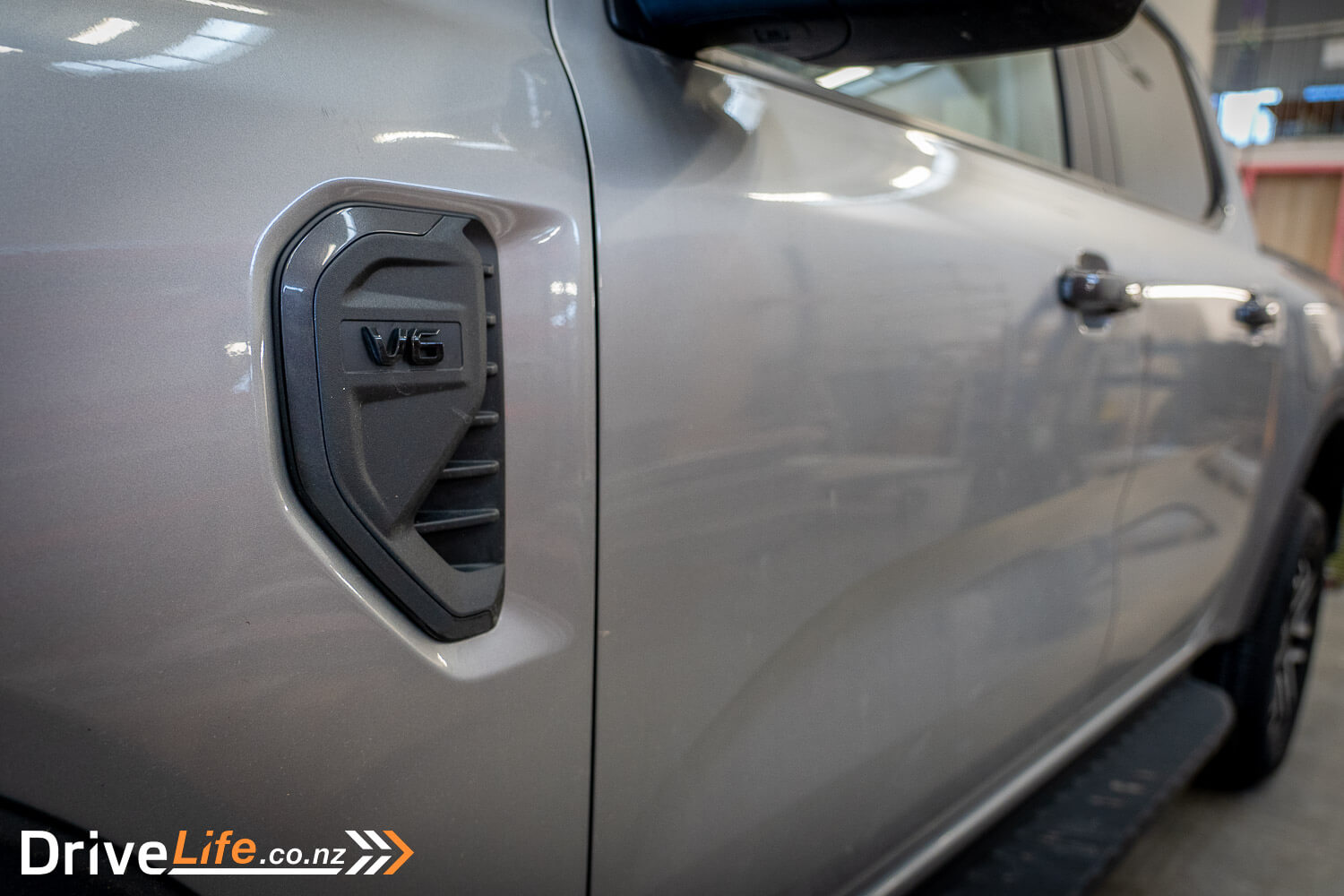
What’s The Interior Like In The 2022 Ford Ranger Sport?
Along with the exterior, the interior has undergone huge changes. It looks more luxurious, at a first glance that’s probably down to that large centre screen.
But it still looks like a work truck in many ways, with hard black plastic panels where they’re needed, and rubber mats proudly adorning the floor. As mentioned, our test car had been used for the launch of the Ranger and much of that launch – most of it, actually – was offroad, so apologies for the mud in the photos. It’s going to take more than a quick vacuum to tidy this Ranger up.

The new Sport model has some nice leather bucket seats, complete with ‘SPORT on the top of the seats.
Rear legroom is about the same as the last model, so it’s pretty good in the front, and better in the rear. Headroom seems to be the same too, and there’s plenty for those who are not height-challenged.
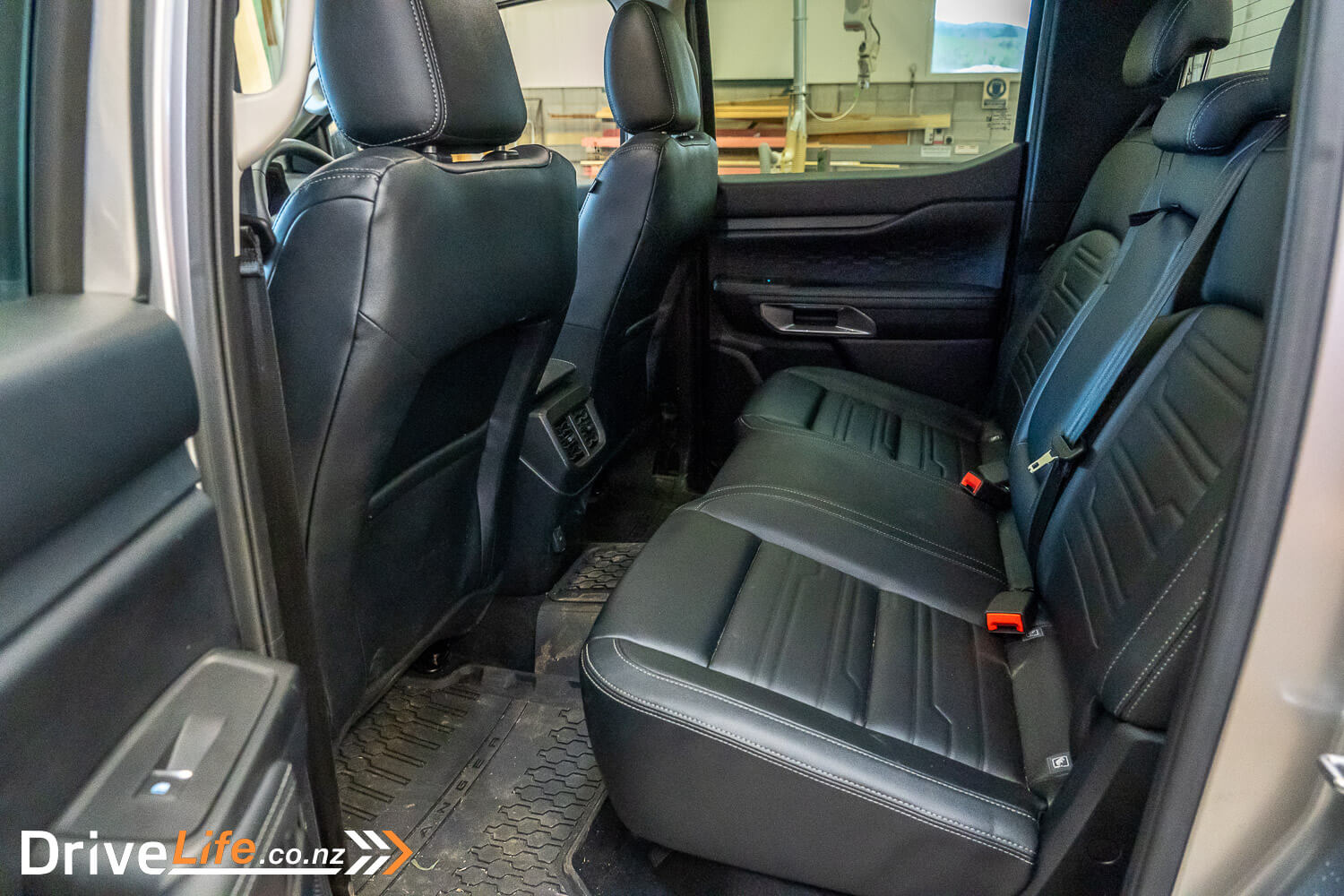
It was nice that the doors open wide on this next-gen, making it easier for entry and exit. Speaking of doors, Ford went to some lengths to explain why they’ve changed the interior door handles. After over 5,000 customer interviews and spending time in “a day in the life of a Ranger owner”, Ford engineers discovered that as owners as previous-gen Rangers were exiting the ute they’d need to use two hands, and this was often difficult if they were trying to hold something and get out. So Ford redesigned the door handles so that you can open the door with one hand, while still holding the grab handle with the same hand. It’s a simple and ingenious design, and it works perfectly. It does make other cars that don’t do this seem quite antiquated, but it does have to be said that many English cars had this same sort of setup in the 1960s, so we’ve come full circle, and are better off for it.
Once you’ve climbed into the driver’s seat, you’ll notice the nifty animated logo on the dash, complete with a “Built Ford Tough” slogan on it. Admittedly, it does catch your eye, especially since the Sport model has an 8” digital cluster. There are no dial gauges on this dashboard, but it is full colour and takes little time to get used to.

Front seat passengers have access to both a single USB-A and USB-C port, no doubt this is the result of more of that customer feedback. We don’t all have USB-C phones yet. Next to the USB ports is a Qi wireless phone charger, decent in size too and nicely rubberised so your phone will not move, even in the rough stuff. In front of the passenger is a rubberised shelf, just about the right size for a cellphone, or some screwdrivers.

There are also some USB ports up by the mirror for your dashcam.
The glovebox is small to average in size, and on the right-hand side of the steering wheel is a small cubby, just about perfect in size for a bunch of business cards for that plumber or sparky. At each end of the dash are some pop-out coffee cup holders, along with two more on the centre console, and two drink bottle holders in each door.
Like before, the interior on the new model is quite light and airy, even though all of the upholstery is black. There’s beige headlining and pillars to help lighten the interior up.
Around the back, Ford has put thought into this ute’s employment. There is a measuring ‘tape’ across the back of the tailgate, so if you’ve forgotten your tape measure and need to cut that 4×2 on the tailgate, don’t worry about it. The cargo box itself is wider than before, has external tie-downs and a plastic boxtop and tailgate is standard. There are internal rails in the cargo area with adjustable cleats to secure your load. Lighting for the cargo area has moved to under the lip of the tray. This was from customer feedback where they said once you have a cover or shutter over the tray, a light on the roof of the cab is useless.

There are also some sprung covers on the top of the tailgate, which you can use to insert a G clamp to hold your timber in place while you cut/drill it. It’s simple, and brilliant. Being a work truck, there are also a couple of cup holders on the tailgate for your keep cups. The tailgate itself is nicely counter-weighted, so never feels heavy. It carries an embossed “RANGER” on it.

Not so brilliant is the bonnet, very heavy, and with no gas struts. Not that it’ll get opened often but I wasn’t expecting a stick to hold it up.

What’s The 2022 Ford Ranger Sport Like To Drive?
On the launch, we spent most of our driving time offroad, so it was hard to judge what this ute would be like on the open road, or as a Daily Driver. I was aiming to do over 1,000Km in the next-gen Ranger, so would definitely be testing it out as much as I could. In February of this year, I spent 1,600Km in a bi-turbo Wildtrak as part of our Project V8 series, so both the driveability and fuel consumption could be compared at the end of this trip.
Before hitting the road, I’m happy to report that hooking up my phone via Bluetooth took less than 30 seconds, and it’s great to see that Ford have included both wireless Apple CarPlay and wireless Android Auto. It’s a rarity to see both these as cordless.
The 10.1” screen in the Sport model is crisp and clear, bordering on the level of a Tesla. It’s a full portrait screen which is great for height, but it does mean that your reversing camera has a very narrow view. It’s still an extremely clear reversing camera, with a great top-down view of the towbar, but the narrowness of the screen does mean you lose some of that detail. This is where the Wildtrak model with its 12” screen would be better. There can be a little bit of lag between screens, but it’s more than acceptable.


The first part of my trip back to Wellington would be to Tirau, over 250Km away. The Ranger Sport and I hit the road north to Napier, then headed across SH5 towards Taupo. While that V6 diesel impressed me offroad, it impressed me even more on road. It’s so incredibly smooth and quiet, you’d swear it was a petrol V6. Even at idle on the outside, it sounds like a petrol V6.
The delivery of power is linear, and since it has 600Nm of torque performance is effortless. Yes, I was running an empty ute, but you can feel the potential of this engine at all times. At 80Km/h (the limit on SH5), the engine is almost silent. At 100km/h, there’s no engine noise, tyre and road noise is negligible but there is a little wind noise from the top of the door frames. It’s a bold thing to say, but I stand behind it: The next-gen Ranger has lifted the bar for refinement across the entire ute sector.
The 10-speed automatic has also had an upgrade, and is still excellent. Changes are almost seamless, putting a nail in the coffin of a constantly variable transmission (CVT). There’s no hunting up and down the ‘box as you think there might be, and unless you floor the throttle, there’s no way of knowing the truck has changed gear. It’s a brilliant transmission, and an excellent match for the engine. The new model has a Tow/Haul mode that will adjust the transmission’s changes to suit the load, or delivers the right amount of engine braking down a hill, among other things. Braked towing capacity is 3,500Kg, same as the outgoing model.
With just over half a tank of diesel, my range on leaving Havelock North was 267Km. The further I drove, the more range I got, showing me that off-roading this ute had done had obviously sucked the diesel. On getting to Tirau, I now had over 300Km of range in the tank, with fuel consumption sitting on 8.6L/100Km – a fantastic result for a 3.0-litre V6 engine.

My Tirau visit over, it was later in the afternoon and time to head to Whareroa, on the west side of Lake Taupo, for the night. Deciding to head to Whareroa via the Western Access route, I hacked a right at Tokoroa. That Western Access route means lots of long sweepers and tighter bends. Initially, I left the Ranger in Eco mode – so two-wheel-drive – to see how it went on a 100Km/h damp road. It did bloody well, the grip excellent. Some body roll, yes, but all very manageable, predictable, and safe.
Once it started raining, I stuck the Ranger Sport into 4A mode. The next-gen Ranger can now do four-wheel-drive on tarmac, using clutch packs in the centre diff to stop the front or rear diff from binding up. It works beautifully, although I couldn’t actually feel that the car was now in 4WD, since it does so well in 2WD.
The next day, four of us headed back to Tirau for the day. Even four up, performance remained about the same, with my passengers surprised at the engine’s refinement. Honestly, this new V6 is outstanding in all respects. I think if you went and drove the new-and-improved bi-turbo you’d be impressed. But then you’d test out the V6 and it’s all over. It’s a world apart from the bi-turbo 2.0-litre.
On the return trip to Wellington, I decided to head up to Tukino Ski Field to get some photos for this review, and for two other reasons:
· I’d never been all the way to top
· It was forecast to snow
Those who familiar with the ‘road’ up to Tukino will know this is no easy forestry track. It’s relatively gnarly, with some steep, rocky gradients to climb. Add to that impending snow and slush, and this should be a reasonable test of the next-gen Ranger’s capacity off the tarmac.

The first part of this track is not too hard, and I managed to cruise along at 70km/h at a few points, the Ranger’s suspension soaking up the bumps in the track. I’m going to call it now: the new Ranger is leading the entire class when it comes to ride quality off-road. I know we mentioned this in the launch article, but that was on fairly easy tracks. The Tukino ‘road’ is infinitely more of a test than the tracks we went on during the launch. Part of this improvement in ride quality is down to the moving of the dampers to outside the springs, always a great way to improve the ride in an empty ute. The track is also wider by 50mm front and rear, and there’s been an increase in the wheelbase as well. These changes have improved the ute’s approach and departure angles, says Ford, and now they are 28.5 degrees approach (was 30) and 21 degrees departure (with a towbar), which was 23.5 degrees. Front overhang is now 865mm (was 908mm).
Another change to the new model is the all-new chassis. The 2022 Ranger is built on the “third-generation T6 body-on-frame global architecture”. Ford says this new frame creates more space under the hood, improves airflow, and leaves space for an auxiliary 12-volt battery.
Back to Tukino, and the Ranger simply cruised along, even up the first decent uphill section that’s littered with rocks. Then I got to the slushy snow. I cruised along without the diff lock on, leaving the car in 4H and it just got on with it, with no dramas, no stopping and backing up of any sort. The knob on the centre console has buttons for selecting your drivetrain mode; 2H, 4A, 4H, or 4L. You can shift on the fly between 2H, 4A and 4H, but if you want to go into or out of 4L, you’ll need to stop and engage Neutral first. 4A (automatic) continuously distributes power between the front and rear axles.

Turning the same knob allows you to switch the drive modes, selecting from 6 that are Normal, Eco, Tow/Haul, Slippery, Mud/Ruts, and Sand.
On the way to the ski lodges, I passed 3 SUVs and utes from other brands, all putting on chains. The Ranger and I drove past, waving like the queen. In a few places the rear end started to get a bit loose, so it was diff lock on, and the car stayed straight all the way to the top. The off-road screen on the Sport model is activated by a button just in front of the console cubby; it shows roll, pitch, diff lock status, steering angles, and a drivetrain diagram. You can turn the diff lock on and off from this screen, ditto activating hill descent control.
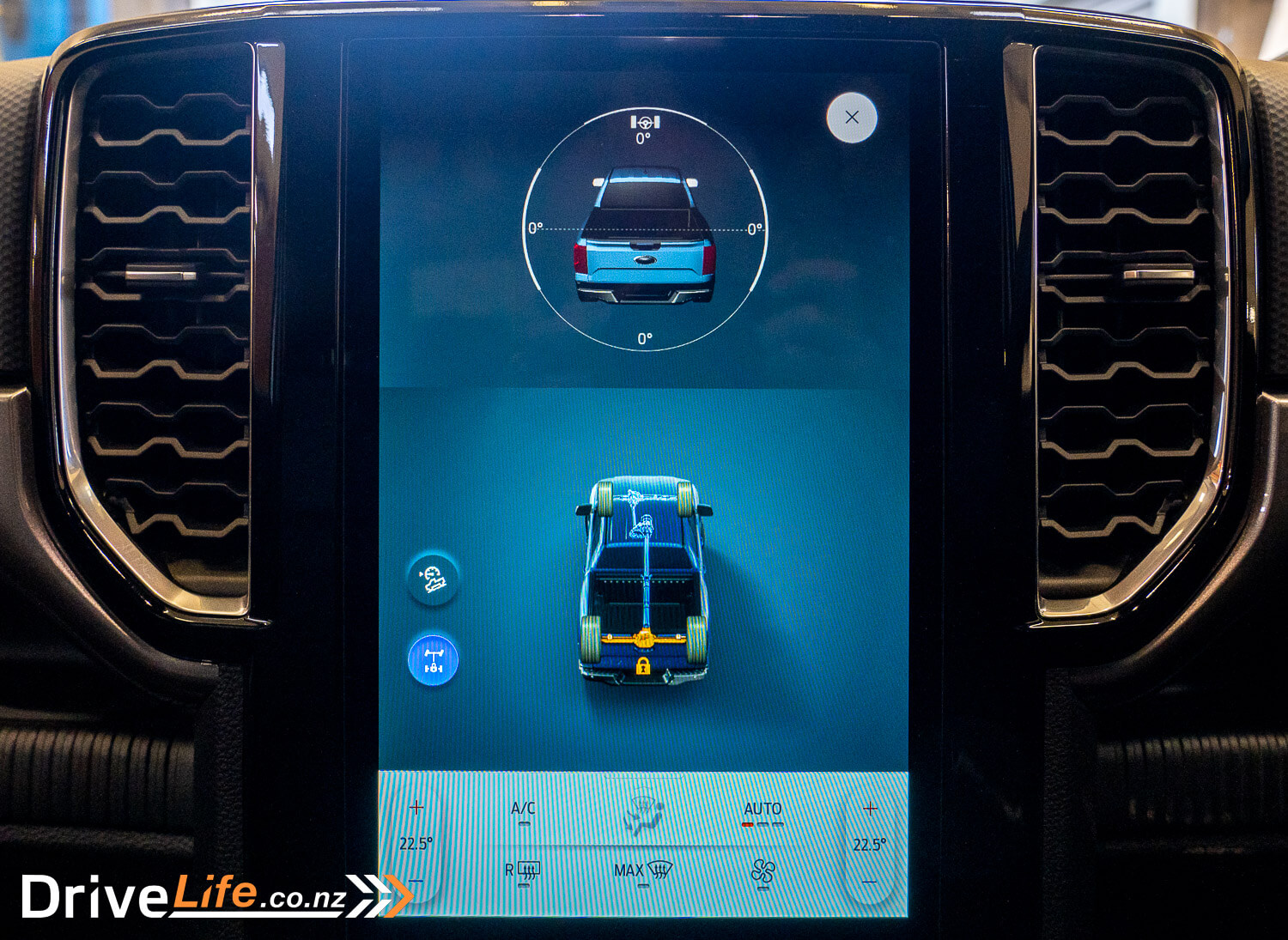
Getting to the top off the track and the ski lodges, a snowstorm of sorts hit and put an end to ideas of photos at the top. After a coffee, we started the trek back down the hill – going past a certain ute (with a model name starting with a H) that was stuck, and busy putting chains on.
I found a clear spot further down the hill for photos, but the weather only stayed clear for a few minutes, turning pretty nasty. I hit the track down again, as the Ranger got more covered in snow.
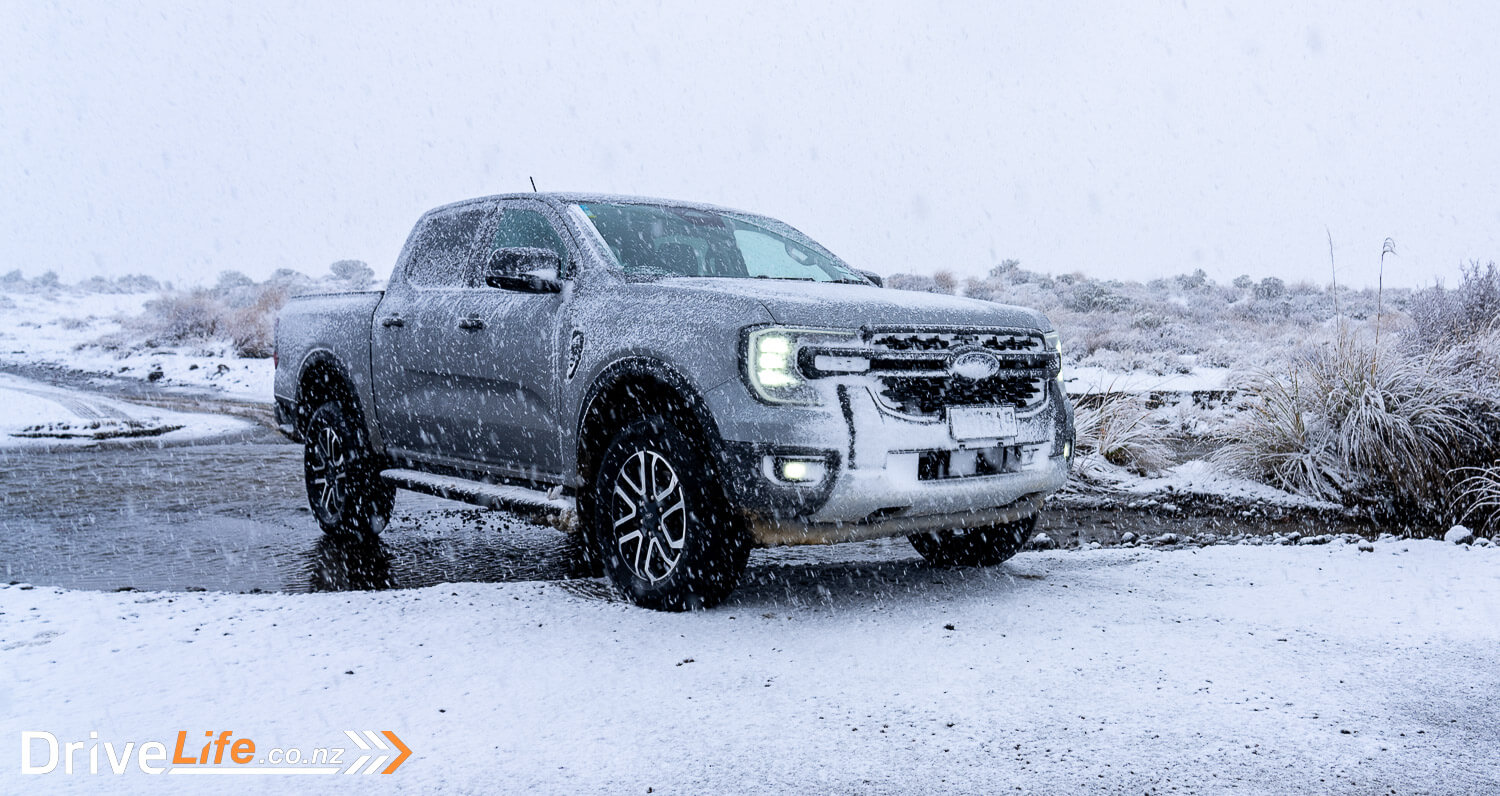
This next-gen Ranger is now fitted with rear disc brakes, and it really makes a difference. I didn’t think the ‘old’ drum rear brakes were bad, but the new setup invokes confidence, and the pedal feel is surprisingly good. Coach stops are a doddle, and the overall braking performance is excellent. Note that disc brakes are only fitted to models XLT and above. The new Ranger does have an integrated electric brake controller (at last!) and I can see this being appreciated by many people who tow caravans and other heavy trailers.
Needless to say, I was pretty impressed with the Ranger’s performance to and from Tukino ski field. While I wasn’t majorly off-roading, I expect a track like the one I had just finished would be the most adventurous that most Ranger owners would ever go on.

Back on SH1 and heading south, time to take in some good, great, and no so great points of the next-gen Ranger. I love that when using adaptive cruise control it’s a one-touch affair; just hit the button and it’s set. Not only that, but as you pass a speed limit sign, adaptive cruise will adjust your speed automatically up or down to suit the new speed limit. Brilliant, and it works seamlessly. It’s not jerky at all; say you are doing 100km/h and then pass an 80km/h sign, the truck will not hit the brakes hard, but will instead slow down gradually. This is good for a smooth ride, but it does mean you are exceeding the limit for the amount of time it takes for the Ranger to slow down, so keep that in mind.
It also works for the speed limiter, so if you want to use that instead of adaptive cruise, you will get the same automatic speed-change function.

Another nice function is the brake auto-hold; just press the brake pedal a little harder at the lights or a stop sign, and all the brakes will lock on, then they’ll release as soon as you hit the gas pedal. Other brands do this, but you normally need to engage brake auto-hold every time you start the car. Ford has a button for this in the menu system, so just set and forget.
Visibility is also good, except for a largish C pillar. The Ranger’s Lane Keeping System does a good job, although it favours the right hand side of the lane – perhaps some carryover from a USA engineer. The new system doesn’t need a line on the left side of the road to detect; it has Road Edge Detection in case you are on a metal road, or a road with no fog line.
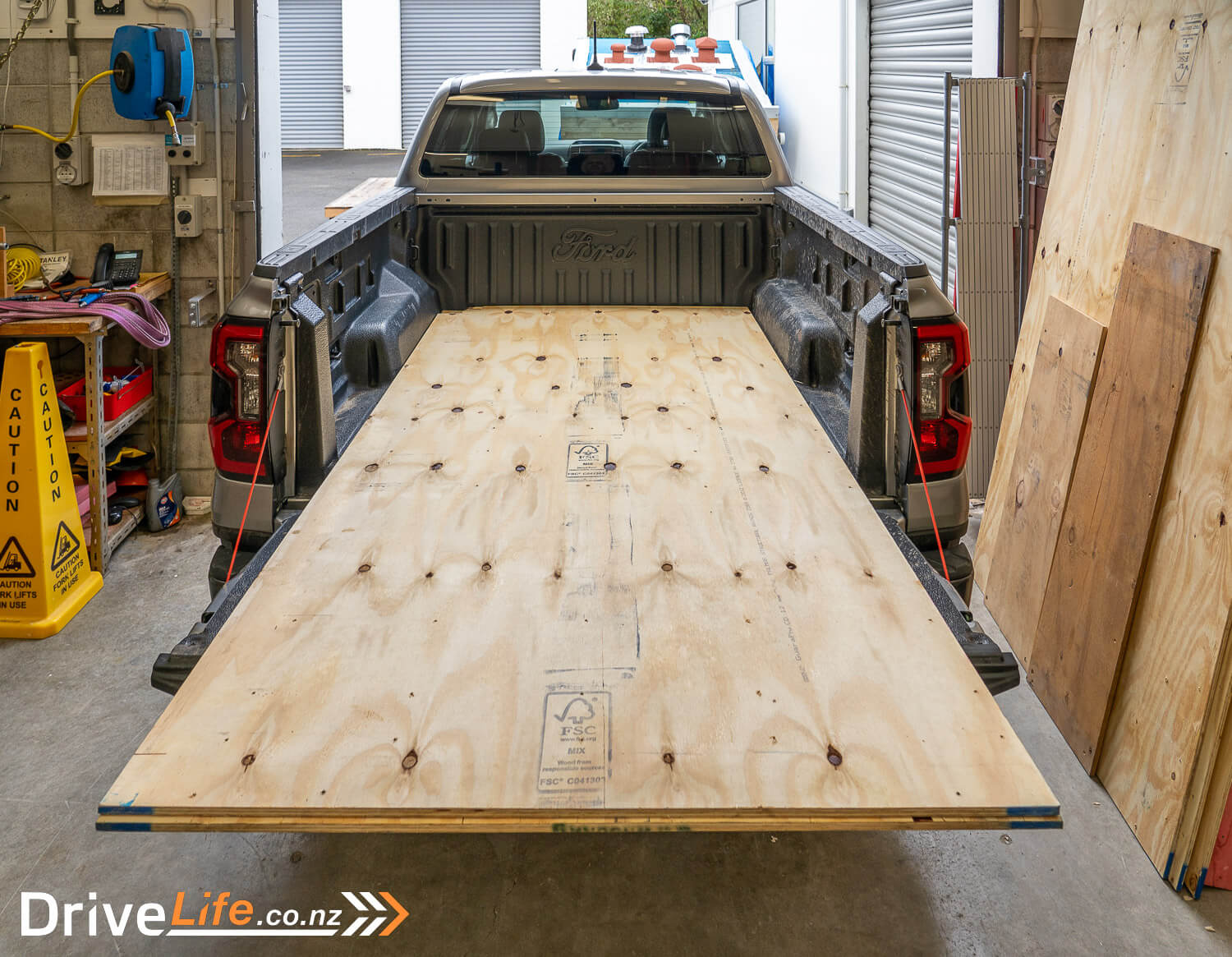
The headlights on the Sport model are LED and they are adequate, but lack depth in the black of night. There is a thumbwheel on the right-hand side of the steering wheel for adjusting the headlights, but even all the way up they don’t cut deep enough. The other downfall – for me at least – is that when you turn them on manually, they switch off when you get out of the truck. I drive with my headlights on all the time, day or night, so had to remember to turn them on each time I started the truck. Not a biggie, but a bit painful.
If you do a lot of towing, Ford’s BLIS system might be handy. Here’s their description of it:
BLIS with Cross-Traffic Alert and Trailer Coverage5 is a first for Ranger and offers Blind Spot Information System (BLIS) coverage for pick-up models and the trailer it’s towing. Using sensors built into the taillamps, BLIS can alert the driver when a vehicle in an adjacent lane is detected in the blind spot, which helps avoid collisions when switching lanes. In vehicles fitted with Ford’s factory Tow Pack4, the Trailer Coverage system can be set to the length of the trailer, supporting trailers up to 2.4 metres wide and 10 metres long. The system also allows you to store your trailer’s dimensions for quick setup. Once set, the system re-adjusts to account for the trailer, picking up vehicles in the customer’s blind spot sooner.

Integrated SYNC 4A features such as trailer connection checklist & Trailer Light Check simplifies the task of connecting your trailer by no longer having to rely on another person to act as a spotter, or for the driver to have to get out of the vehicle. If you are on your own and hooking up a trailer, this could be a real boon.
It was interesting to see that euro-style feature of parking lights activated by the indicator stalk. I haven’t seen this on a car for a while, and it caught me out initially. It means that if you (for example) leave the indicator stalk on the left and then lock the truck, the left front C DRL and left-rear taillight will stay on. Leave the indicator stalking pointing right, and the right side comes on. I’ve seen some drivers previously who thought this was a fault in a car, but it’s all by design and I can see it’s usefulness in a tight street.

Ford have introduced an ‘E-Shift’ transmission lever in this next-gen model. After lots of customer consultation, and they all said do not give us a rotary dial. So Ford compromised; it’s not a standard gear lever, but uses less space than one and is pretty easy to use. Manual mode is engaged by hitting the M button on the right-hand side of the shifter, then using the +/- buttons next to the M button. The shifter is motorised, so say you forget to put your Ranger in Park when you get open the door, well the Ranger will put the car into park for you. It’s a bit geeky, but it’s quite cool to see the shifter move by itself from D into P. Initially, I kept pushing the lever too far and going from (for example) D to P, when I wanted R. By the end of my week with the car, we were all good. It’s easy to use the lever like a normal shifter, but it doesn’t need that much force to shift.
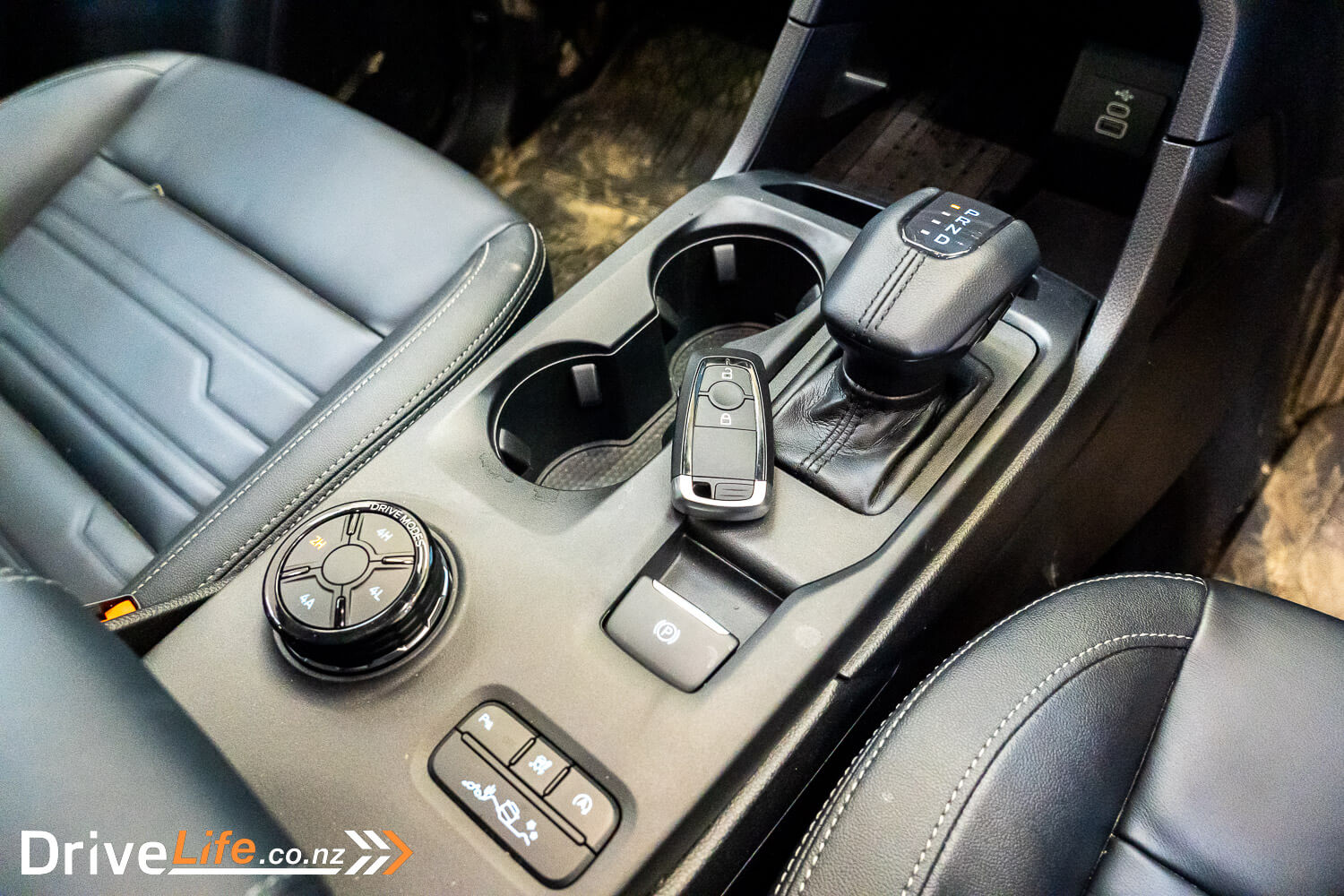
As mentioned, that centre display has amazing clarity, and also this model has SatNav built-in. That’s great and also the SatNav will show you the cost of diesel as you are approaching a gas station, so you can compare prices on the fly. This is a great idea, but the prices shown on our test ute’s screen were quite a bit out of what they actually were.
One thing I missed in the Sport model is heated seats. You have to go to the top-spec Wildtrak to get them, which is a shame. In our recent winter tempreatures, they would have been very handy. Yet another reason to go for the V6 Wildtrak? Yes.

New to the Ranger is an alerting system which actually works. You’ll get one beep every now and then if you are exceeding the posted speed limit, and two beeps for other hazards, like a speed camera, red light camera, or school zone. The beeping isn’t loud enough or too regular to be annoying, and is actually quite handy.
One small thing that wasn’t so great on our test car was some drivetrain vibration between 70-90km/h. It wasn’t bad, but I could feel it through the seat, regardless if the truck was in 2WD or 4WD. This could have been specific to our test Ranger, though.
After that weekend away, I noticed that I hadn’t thought about the seats at all. That’s because they are borderline Goldilocks: just right. They initially feel quite firm, but after a 1,000Km weekend, not at all. My rear seat passengers on that part of the trip also commented on the comfort levels.

The 6-speaker audio system on the Sport has a quality far better than I thought it would, with excellent separation. The steering wheel controls for audio are split, not my favoured way of doing it but that’s just me. This means volume up/down is a left/right button on the left side of the steering wheel, and track/station change is on the right side of the wheel.
After using this Ranger for a week and covering 1,500Km of varying roads and conditions, my fuel consumption worked out at 8.9L/100Km. If you’re used to a hybrid, this will seem high, but put it in perspective; when we tested the 2.0-litre bi-turbo Ranger out in February, that returned 10.1L/100Km on a long trip, before we hitched the trailer up. So this 50% bigger engine with 50% more cylinders – and smoothness – is more economical than the outgoing 2-litre. Ford suggests 8.4L/100km for the V6, so we weren’t far off that. It will be interesting to see if the upgraded bi-turbo is more economical than the last when we get one to review.

2022 Ford Ranger Sport – Specifications
| Vehicle Type | 4-door Ute |
| Starting Price | $80,490 |
| Price as Tested | $80,490 |
| Engine | 3.0-litre, V6 turbo-diesel |
| Power, Torque kW/Nm | 184/600 |
| Transmission | 10-speed automatic |
| Spare Wheel | Full-size steel |
| Kerb Weight, Kg | 2,346 |
| Length x Width x Height mm | 5359x1850x1815 |
| Fuel tank capacity, litres | 80 |
| Fuel Economy, L/100km | Advertised Spec – Combined – 8.4 Real-World Test – Combined – 8.9 Low Usage: 0-6 / Medium Usage 6-12 / High Usage 12+ |
| Towing Capacity Kg, unbraked/braked | 750/3,500 |
| Turning circle metres | 12.8 Small: 6-10m / Medium 10-12m / Large 12m+ |
| Warranty | 5 Years, 100,000Km |
| Safety information | ANCAP Rating – 5 stars – Link Rightcar.govt.nz – 5 Stars – PGT819 |
Have you enjoyed this review? Be sure to join our monthly email newsletter list so you don’t miss a single car review!








